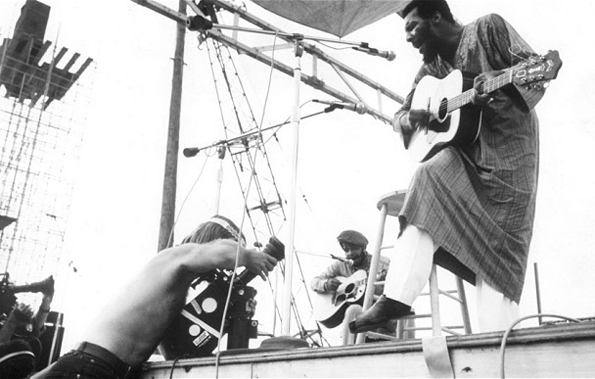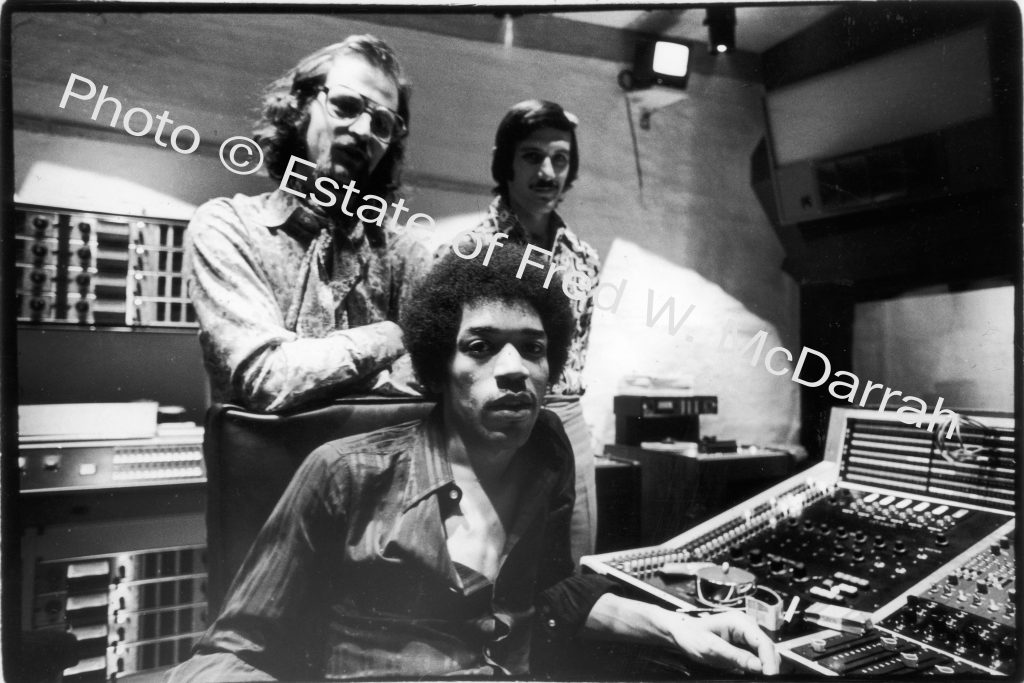Woodstock: Three Days of Peace, Music, and Greenwich Villagers
On a farm far from the city on August 15, 1969, the Woodstock music festival entered into history and helped define a generation. The “Aquarian Exposition: 3 Days of Peace & Music” was held at Max Yasgur’s dairy farm which was actually in Bethel, New York. Woodstock marked a pivotal moment in music and countercultural history, which still resonates to this day.

It took a lot to make that era-defining festival happen. And as filmmaker Laura Archibald said “And by the time we get into the late ’60s, concerts like Woodstock were being put together, and where did they go to get their talent pool? Ah, the Village!” In fact, Villagers opened, closed, lit, emceed, and provided some of the most memorable performances of the Woodstock Festival.
It starts with the lighting design, as well as the well-known warning about the “brown acid,” both of which came from Chip Monck. Monck began working at the Greenwich Village nightclub The Village Gate in 1959. He was doing the lighting for comedians and jazz and folk artists, and living in the basement apartment under the same club where Bob Dylan eventually wrote “A Hard Rain’s A-Gonna Fall” on Monck’s Selectric typewriter.
In 1969 he was hired to do the job that would transform his career — plan and build the staging and lighting for the Woodstock Music & Art Fair’s “Aquarian Exposition” music festival. Then just before Woodstock kicked off, he was drafted to serve as the master of ceremonies as well, because organizers had forgotten to hire one. This is where his memorable announcement about the “brown acid” came in:
“To get back to the warning that I’ve received, you might take it with however many grains of salt you wish, that the brown acid that is circulating around us is not specifically too good. It’s suggested that you do stay away from that. Of course it’s your own trip, so be my guest. But please be advised that there’s a warning on that one, okay?”
The very first performer on the stage at Woodstock was Greenwich Village musician Richie Havens, who lived at 106 Waverly Place.
Richie Havens, the iconic singer and guitarist, passed away in 2013 on April 22 at the age of 72. Though originally from Bedford-Stuyvesant in Brooklyn, by his late teens Havens had moved to Manhattan and made his home in Greenwich Village, which was in the midst of the beatnik/folk revival scene of the late 1950s and early 1960s.
The Times noted that Havens “wandered the clubs working as a portrait artist. After a few years he discovered folk music, and he was soon playing several engagements a night at clubs like Why Not? and the Fat Black Pussycat.” By 1965 and 1966, Havens had released a couple of demo albums of his work, and in 1967 in partnership with Albert Grossman (who helped discover Bob Dylan), released Mixed Bag, his breakout work in 1967.
But it was Havens’ opening performance at Woodstock in 1969 that helped introduce his unique guitar sound to a national audience. After that, Havens recorded numerous albums and toured the world, only giving up touring in 2012 due to health reasons.
Then in the middle of the festival came an impromtu performance from John Sebastian of the Lovin’ Spoonful.

Sebastian was not scheduled to perform at Woodstock. He went as a spectator, but was asked to perform an acoustic set after a rain break because amps were not set up on stage for Santana yet. Sebastian’s Woodstock set consisted of three songs from his recorded but not yet released John B. Sebastian album (“How Have You Been”, “I Had a Dream”, and “Rainbows All Over Your Blues”) and two Lovin’ Spoonful songs (“Darling Be Home Soon” and “Younger Generation”).
Most people know that the Lovin’ Spoonful, like so many American folk/pop/rock acts of the era, got their start in the clubs of Greenwich Village. More than that though, John Sebastian grew up in a musical household in Greenwich Village; his father was a noted classical harmonica player and his mother a writer of radio programs. Regular visitors to the family’s home overlooking Washington Square Park included Burl Ives and Woody Guthrie.
John became a fan of, and then a participant in, the folk music revival that swept the nation in the late 1950s. He started in the Even Dozen Jug Band, playing guitar, harmonica and autoharp. He soon became a sought-after accompanist on the Village folk scene, working with Fred Neil, Tim Hardin, Mississippi John Hurt, Judy Collins, Bob Dylan and many others. Soon after John joined the Mugwumps, a folk band which included future Mamas and Papas Cass Elliot and Denny Doherty. When the Mugwumps split up, John and guitarist Zal Yanovsky formed the Lovin’ Spoonful.
The Lovin’ Spoonful got their start practicing in the basement of the Albert Hotel on University Place (where many an aspiring Village musician or artist lived at the time) and eventually performing at the Night Owl Cafe, which was located at 118 West 3rd Street, and was one of the premier showcases for up and coming musical talent in the Village at the time.
Another Villager who performed at Woodstock was Joan Baez, who throughout the 1960s pushed the envelope of folk music and aligned herself with the civil rights movement. She first met Bob Dylan at Gerde’s Folk City in Greenwich Village. By then Baez had already released her debut album and was emerging as the “Queen of Folk” who would introduce the then-unknown Dylan or invite him onstage.
She recalled Woodstock some years later to Rolling Stone magazine:
Everybody was crazy. I guess the collective memories that people have, I have in a sense. It’s the mud and the cops roasting hot dogs and people wandering around in the nude. And the fact that, looking back, it was in fact a huge deal. I think of the events that happened around that time, it was a perfect storm, which is why people wish they’d been there. And not just Woodstock, but the whole time period when it was music and people feeling community with each other because they had either been in the civil rights movement or the movement against Vietnam.
It was like a perfect storm and I realized that Woodstock was like the eye of the hurricane because it was different. It was this weekend of love and intimacy and attempts at beauty and at caring and at being political. And because it was isolated like that, somehow it was safe and those things could happen. That’s why a cop could roast hot dogs and put his gun in the front seat of his car and not worry about it because it was this extraordinary safe place.
Baez lived with Dylan at the Hotel Earle (now the Washington Square Hotel) on Waverly Place, as well as other locations throughout the Village.
One of the highlights of the second day of the festival was Janis Joplin’s performance. The Blues-belter performed a memorable ten-song set, which included some of her most celebrated tunes, such as Summertime, Try (Just a Little Bit Harder), Piece of My Heart, and Ball and Chain.

Towards the end of her short life, Joplin lived at 139 West 10th Street, over the Ninth Circle, where she would also sometimes perform. She died of a heroin overdose just a little over a year after her Woodstock performance.
Anf of course the closer for the Woodstock Festival was the ax magician himself, Jimi Hendrix. Who doesn’t know the opening notes to his Woodstock performance? Who can’t recognize the wild, seething energy behind them? Who hasn’t seen his face, wavering with smoke and mystery? We heard him at concerts and celebrations all over the world. We watched and heard those first stark notes at Woodstock. We see him in his bright, colorful outfits. We see him poignantly. A face of a generation, yes; also a face of loss, of danger, a face of the 27 club along with too many others whose music we might still be hearing today. He is a face of a movement, of a generation, and of the Village.

We saw him in the recording booth at his own Electric Lady Studio on West 8th Street, mixing up his magic. We’re told that after Woodstock Jimi returned to his apartment in a pre-war building at 59 West 12th Street; Jimi’s apartment has since been combined with another apartment in the building, gut renovated and sold for millions. As far as we know, this is the only lease Jimi signed, though he lived elsewhere and crashed everywhere as he traveled the world touring, playing, making art and friends. John Storyk, a Manhattan architect who helped Hendrix design the recording studio and its acoustics, said he recalled Hendrix living in a cottage at 50 West 8th Street one wall away from Electric Lady Studios.
Like so many of the great cultural moments of the last two hundred years, Woodstock would not have been Woodstock without Greenwich Village. To find out where many more musicians, artists, writers, and history-makers lived in Greenwich Village, check out our Greenwich Village Historic District 50th Anniversary map at www.gvshp.org/GVHD50tour.
In 2017, the festival site was listed on the National Register of Historic Places.

